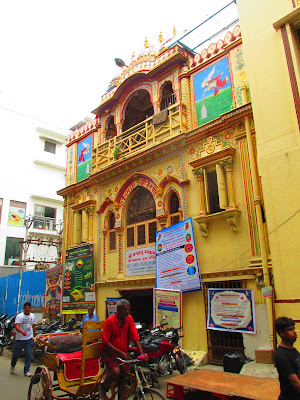Juna Jain Mandir of Chennai
Sowcarpet is the locality of Chennai, where many North Indian and Gujarati communities are still found. Ananda Ranga Pillai, in his famous diaries of 1746 CE, mentions about the Gujaratis of Madras.
After the formation of Black Town, many Gujarati families migrated to Sowcarpet. The migration continued till the 1950s. The migration happened not for a particular reason, and different groups of Gujarati-speaking people migrated to Sowcarpet. It included the Gujarati traders from Gujarat, Khedaval Brahmins who had already migrated to Thanjavur, Gujarati Jains, etc. Hence, it is unsurprising to find so many Gujarati Jain temples in Sowcarpet.
 Two notable Jain temples are located on Mint Street in Sowcarpet. One temple, rebuilt with white marble in 1994 CE, was constructed where the original Jain temple stood for about 90 years. Another temple on Mint Street is much older than this one. It is referred to as Juna Mandir. (In the Gujarati language, Juna means old). I could not find any records on the date of construction of the original structure of this temple. However, the original temple could have been built in the late 1700s or early 1800s. The wealthy community that migrated to Sowcarpet in the middle of the 18th century would have made their temple by then. The current structure of the temple is hardly 100 years old.
Two notable Jain temples are located on Mint Street in Sowcarpet. One temple, rebuilt with white marble in 1994 CE, was constructed where the original Jain temple stood for about 90 years. Another temple on Mint Street is much older than this one. It is referred to as Juna Mandir. (In the Gujarati language, Juna means old). I could not find any records on the date of construction of the original structure of this temple. However, the original temple could have been built in the late 1700s or early 1800s. The wealthy community that migrated to Sowcarpet in the middle of the 18th century would have made their temple by then. The current structure of the temple is hardly 100 years old.Although the temple is referred to as the Juna Mandir, the actual name of the temple is "Shri Chandraprabhu Bhagwan Jain Swetamber Temple".

The sanctum enshrines the white marble image of Chandraprabhu Bhagavan in the middle. He is the eighth Tirthankara of the Jains. On either side, Sambhavnatha, the third Tirthankara, and Sumatinatha, the fifth Tirthankara, are found.



.JPG)


Not gujratii, but marwaris (Rajasthani) . It's true that our saints are mostly gujratii n marwaris
ReplyDeleteWhat is not Gujarati?
Delete